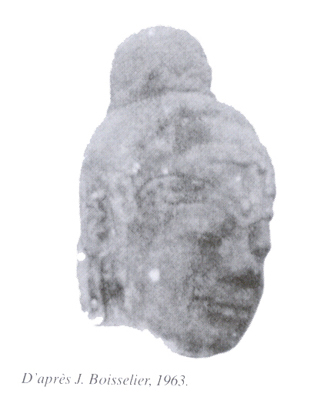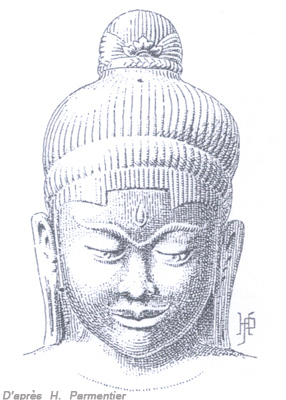In 1918, two sandstone statues from Dong Phuc (District of Binh Dien huyen Binh So'n in northern Quang Ngai) entered the Museum of Touran (Da Nang).

Marie-Christine DUFLOS1
They had been found before 1900 in the larger of the two mounds at the site 2 km south-east of the mission of Cu Va where they were transported to 19012. These are the only sculptures that H. Parmentier has been in the area between the Song Tam (southern Quang Nam) and the Song Tra Kuk (northern Quang Ngai).
The first, a statue of a man squatting had already lost his head when he entered the museum. The latter is known only by a small drawing of H. Parmentier in Volume II of its Inventory, (p. 471, fig 145 A). The place of preservation of the body we are currently unknown.
The second, a female figure standing with no arms or legs was broken. H. Parmentier said that the head was "separated from the body itself was broken into two pieces during his stay at the rectory (Cham Museum ...: 20). Not content to describe this statue, H. Parmentier made several drawings which, if they can recognize the room, lack of accuracy in détails3. The only old photograph that we know is a cliche EFEO the early 1930s reproduced in the book by J. Boisselier on sculp-ture of Cham 19634. It seems that to date the head had already disappeared. Pictures from 1970 show where the trunk emerges from the pin that held the head place5. The documents at our disposal are difficult to read we reproduce here the descriptions given by the head H. Parmentier and J. Boisselier which we allow to add a few remarks.

For H. Parmentier, "Head-featured enough for shows a frontal eye. The mouth corners are raised and the lips are indicted by a double line giving the misleading impression of a slight mustache ... Hair salon marks a conventional indication of temporal and notches on the front. Small cylindrical tight bun with a braid and adorned with a decoration in front. Pierced ears to move clips real jewelry; hole for receiving a brush before the bun. "(Museum of Ham ...: 19-20).
J. Boisselier says this: "Although the features of this picture still clearly belong to the Style of Dong Du'o'ng, it has various characteristics which also suggest a late phase of the style. The face has a softer expression almost smiling eyes and very elongated include an indication of eyes [...].
The hair is of a type unusual: it is no longer made of braids rated or edged with a border and joined the JATA has become a bun-free roving side. The anterior part of the hair has two depressions that appear only legitimize the existence of a hairstyle reported. H. Parmentier also noted that a hole in a dress before supposed mobile [...].
It is difficult to imagine the identity of this statue has a frontal eye, and whose jata adorned in front with a pattern that seems to be a half lotus. "(Statuary: 132).
We will add that: the photograph, the face is a little more square and full as the drawing of H. Parmentier, smiling slightly at the mouth is large with relatively thin lined lips and the lower edge of the eye is right while the upper eyelid is curved. As for the frontal eye, it is impossible to determine exactly the shape (like drop draws H. Parmentier, or diamond, as is often the case in the Cham art?), But it is placed just above the junction of the eyebrows, almost touching. The shape and arrangement of the bun is, to our knowledge, unique in the Cham art as well as jewel-like flower that appears in front of the hairstyle, half hidden by the braid that maintains the together. The photo shows a small indentation on the forehead, the right side of the cut of hair, probably corresponding to an accident. Finally, the upper edge of the right ear, only visible appears broken.
Although very different in many details of other female statues of Cham art, this work is in the extensions of the style of Dong Du'o'ng.
1 Speaker of National Museums, attached to the Guimet Museum of Asian Art.
2 H. Parmentier, Descriptive Inventory of Monuments Chams of Annam, Paris 1900, t. I: 237-239. H. Parmentier, The Museum of Cham Tourane BEFEO, XICX, 3,1919:19-20; No. 4.1, Uma? and 29, n. 10.5, obese divinity.
3 lnventory ... TLL: 312, fig 79 whole room 322, fig. 84, head, pl. CLXXVI Al costume. Dimensions: 0.84 x 0.23 m or 0.14 m x The head would be about 0.20 m tall.
4 J. Boisselier, La Champa sculpture, research on cults and iconography, Pub. E.F. eo, 1963, fig 66.
5 Guimet Museum, photographs and No. 32413/69 70. The Museum of Sculpture Cam Da Nang, Paris, WAWA, 1997: 118, fig 59.
Article of "La Lettre de la SACHA" n°2, décember 1997, pages 11 et 12.


 James H.W. Thompson Foundation, Bangkok, Thailand.
James H.W. Thompson Foundation, Bangkok, Thailand.